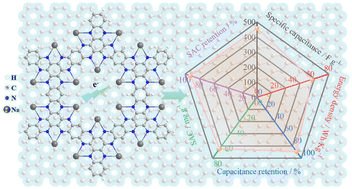Covalent organic frameworks (COFs) with customizable geometry and redox centers are an ideal candidate for supercapacitors and hybrid capacitive deionization (HCDI). However, their poor intrinsic conductivity and micropore-dominated pore structures severely impair their electrochemical performance, and the synthesis process using organic solvents brings serious environmental and cost issues. Herein, a 2D redox-active pyrazine-based COF (BAHC-COF) was anchored on the surface of graphene in a solvent-free strategy for heterointerface regulation. The as-prepared BAHC-COF/graphene (BAHCGO) nanohybrid materials possess high-speed charge transport offered by the graphene carrier and accelerated electrolyte ion migration within the BAHC-COF, allowing ions to effectively occupy ion storage sites inside BAHC. As a result, the BAHCGO//activated carbon asymmetric supercapacitor achieves a high energy output of 61.2 W h kg−1 and a satisfactory long-term cycling life. More importantly, BAHCGO-based HCDI possesses a high salt adsorption capacity (SAC) of 67.5 mg g−1 and excellent long-term desalination/regeneration stability. This work accelerates the application of COF-based materials in the fields of energy storage and water treatment.
